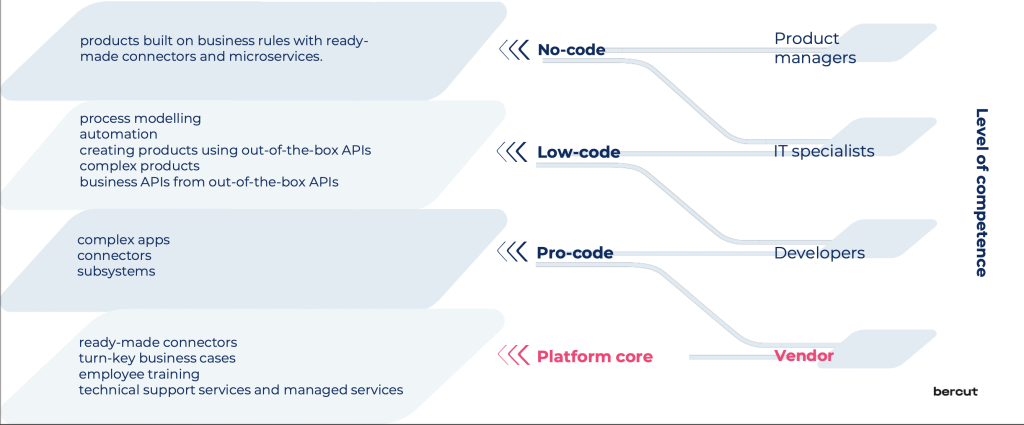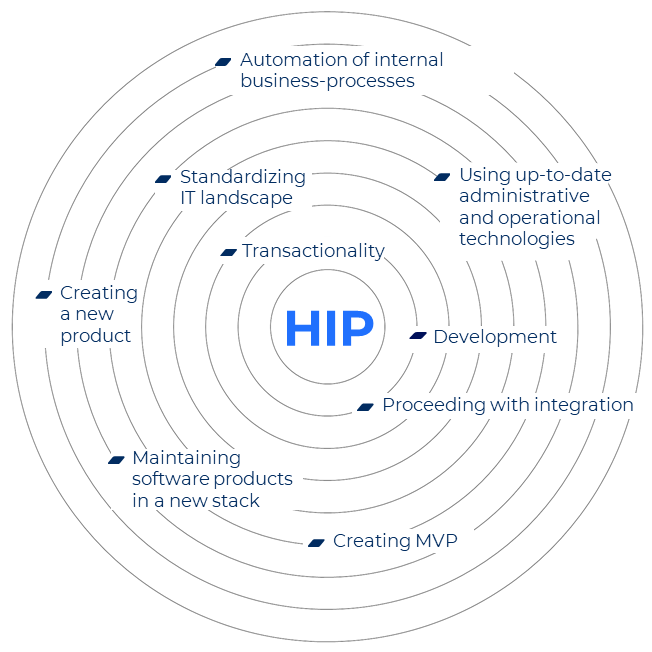Hybrid Integration Platform
HIP is the basis for integrations, creating products and automating business processes

Key advantages:
The platform is actually an ecosystem of software products that allow solving problems of digital business transformation such as:
- integrations
- creation of new products and MVP
- standardization of the IT landscape
- automation of business processes
Support for various types of users
There are different levels for HIP users working with HIP components. Depending on the user’s skills, different platform features may be available.

The competency diagram will help to correctly categorize and assign levels to the users.
- customizable Web-interface and ready-to-use microservices for scripting
- convenient drag-and-drop interface Service Creation Studio
- creation of microservices aimed at solving specific problems
- ready-to-use connectors for systems and technologies
- ready-to-use subsystems
- code generators for easy integration
Business value
profit
introducing innovations, new sources of income and expansion of the partners’ ecosystems
efficiency
independent creation of products, testing hypotheses by launching MVP
optimization
reducing the amount of resources spent by reusing already created tools and integrations, minimizing dependence on the vendor
automation
automation of routines
How it works?
The building-blocks structure of HIP allows to support specific requirements and business tasks, combining the elements of the platform and their functionality:
- BPM (Business Process Management) product creation and automation of business processes.
- Event Management (Processing) easily builds a new business logic for processing events in real time.
- RTSIB (Integration Bus) enables applications, data, and systems to interact with business logic.
- API GW (integration gateway) supports various protocols, providing secure interaction with external systems and partners.
- The Framework is a generous set of tools, capabilities and subsystems for creating additional modules (microservices) and integrating with open source products.
- Message Broker provides real-time communication between systems using a subscription model.

Usage scenarios



Attached materials
Learn more about the Bercut Hybrid Integration Platform. Download product presentation:
Attached products
Bercut integration platforms implement a low-code approach to development, providing users with a ready-made set of tools for independent integration of systems and creation of products in a short time without manual coding.
is an automated system for intelligent response to events
Preparing for Complex Integrated Project in CII Entities
Despite the fact that integration projects are always associated with certain risks and challenges, a modern company can hardly avoid them, as business development and the company’s competitiveness in the market depend on it. However, business software developer Bercut claims that the process can be more manageable and predictable if you approach it smartly at the planning stage.

Bercut at Tibo 2023 International Forum
Bercut will showcase its flagship products, the IN@Voice convergent billing system and the HIP hybrid integration platform — a modern tool for the digitalization of businesses and governments — at the Tibo 2023 International Forum on Information and Communication Technologies taking place from April 18 to April 21, 2023.

Bercut helps Tele2 create new products under other rules
Bercut remained in the shadow of Tele2 for a long time. The technological solutions delivered by the company to Tele2 have drastically changed the performance of that telecom giant. Making payments by a smartphone, retaining a mobile number after switch to another operator and selling unused traffic — all those services have been successfully implemented, also due to Bercut involvement as a BSS partner.

HIP Bercut Named Digital Ecosystem Development Tool of the Year
Bercut received the LOW-CODE AND INTEGRATION PLATFORM — DIGITAL ECOSYSTEM DEVELOPMENT TOOL OF THE YEAR award at the XXII CNews Awards 2022 Ceremony on November 1, 2022. Bercut got the prestigious award for the Hybrid Integration Platform product and the Hypothesis Lab case implemented for Rostelecom using the aforementioned solution.

The Hybrid Integration Platform can Reduce Time-to-market and Development Costs
Business, irrespective of economic sectors, is rapidly embracing digital transformation. To stay competitive, keep and increase profits in a complex and dynamically developing market, companies make use of modern development approaches and tools. One of such tools was the focus of the CNews interview with Ivan Ryl, Product Marketing Department Manager at the Russian IT developer and business digitalization partner Bercut.

Hybrid approach and its advantages over the standard low-code development
Reputable research agencies, such as Gartner, forecast the stable growth of the low-code development technologies market, emphasizing changes in the paradigm and ongoing cost optimization efforts. There are many events taking place today where companies share their experience in implementing short-term cases. At one of such events we spoke about the nature of the hybrid approach and its advantages over the standard low-code development.

Technological trends 2021. The role and prospects of telecom operators
Every year, Gartner, a global research and advisory firm, predicts major trends in the IT market for the coming years. Bercut closely monitors technology forecasts. The way that some of the trends have emerged in 2021, as announced at the Gartner IT Symposium/Xpo 2020 online conference, allows us to rethink the role and opportunities of telecom operators and service providers in the future.

Bercut participates in the meetup "Automated Quality Control of the Code and Development Processes"
On September 30, 2021, Roman Vorobyov, Software Production and Services Support department manager at Bercut, took part in the meetup "Automated Quality Control of the Code and Development Processes".


